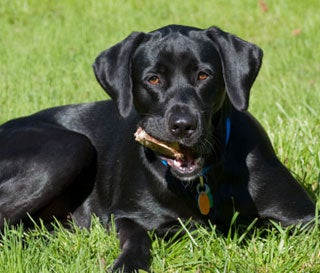Learn about dog breeds
Detailed information & photos on over 190 different breeds
Description
The Labrador Retriever is a well known and respected dog. It is a large dog that is quite tall. It has a muscular body with long legs. Labrador Retriever’s have floppy ears and a long nose. They also have flat tails. The coat can be chocolate, black or yellow in color and almost any shade of those colors.
Coat Description
The Labrador Retriever has a short coat. It is close to the body and does not feel fluffy at all. It is hard and may be smooth or slightly wavy. The undercoat, however, is fluffy, but the outer coat forms such a shield that it can not felt when petting the dog.
History
The Labrador Retriever originated in Newfoundland. It came from the St. John’s Dog breed. These were water dogs and can be the reason for the Labrador Retrievers knack in the water. In the 19th century the dogs began being used for hunting. Today they are popular as pets and can be found all around the world as loyal companions.
Temperament
The Labrador Retriever is a high energy dog. They are a great family pet. However, they require good handling to keep them under control. Labrador Retrievers are also known for being very friendly which means they welcome almost anyone they come in contact with as an immediate friend. However, saying hello often involve jumping up on a person, which can be a hassle since this is a large breed. They can be fun and joyful. Often they get the reputation of being goofy because they just enjoy playing and can be a bit hyper. They also do not reach maturity until about three years of age.
Labrador Retrievers are good with children, but can accidentally hurt them if they are not paying attention. They would never intentionally hurt anyone, but accidents can happen when you are so large in size. With this in mind, children should be supervised with the dog until it is no longer a pup.
Health Problems
The Labrador Retriever can have problems with hip and joint problems. They may also suffer from eye problems, like PRA. They will also eat happily and are prone to overeating which can lead to obesity.
Grooming
The Labrador Retriever is pretty easy to groom. Their coat is repellent by nature and will stay rather clean on its own. They do need regular brushing. Grooming should be initiated early on so a pup understands it is something they must do. The ears should be checked regularly.
Exercise
Labrador Retrievers need a lot of physical activity. As a pup they will seem tireless and need to be able to be as active as possible to help them calm down and not be hyper. If the dog does not have an outdoor area to play they will need at least two or three walks per day. It is best to give them a play area or they can easily tire you out. Even with a play area two walks per day is ideal.
They will quickly wander off or escape if they are not well contained. Leashes should be strong and fences sturdy to keep this dog contained.
They love to swim so some swimming activity is wonderful. They will swim in any type of water, even a backyard pool. This is great exercise and something they can do on their own or with the family, which will make them the happiest.
Training
Training the Labrador Retriever can be difficult due to the excitability of the breed. They have to be taught not to jump, pull or otherwise become too excitable. Some of this will come with age, but controlling the dog from an early age is essential to a well behaved adult dog.
Training should be done is a firm manner. The dog needs to know who is boss and that they need to listen. The training should be consistent and positive reinforcement should be used. They learn very well through repetition. Training of a Labrador Retriever must be consistent throughout its daily life as well. It is not enough to have training sessions and not back it up outside of training. For example, if they are allowed to bark excessively at home, but are being taught to control barking during training, then chances are they will never learn to control their barking because they are not getting the reinforcement at home to back up the training.
The best rewards of accomplishment are going to be physical in nature. The dog should be petted and shown affection. It is not wise to give food treats as this can encourage obesity and overeating problems which are common with this breed.
Overall, training the Labrador Retriever can be a handful, but it can also be fun. As long as good training methods are used the dog can learn a lot from training. As they grow to an adult the effects of training as a pup will become more recognizable.
Advertise | Privacy Policy | Terms of Use | Contact Us © Copyright 2004-2024 PupCity.com. All rights reserved.
